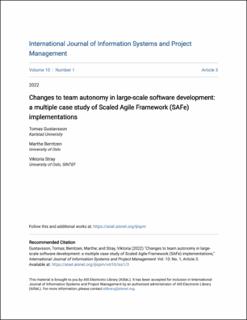| dc.contributor.author | Gustavsson, Tomas | |
| dc.contributor.author | Berntzen, Marthe | |
| dc.contributor.author | Stray, Viktoria | |
| dc.date.accessioned | 2023-03-02T16:09:26Z | |
| dc.date.available | 2023-03-02T16:09:26Z | |
| dc.date.created | 2022-04-29T18:06:37Z | |
| dc.date.issued | 2022 | |
| dc.identifier.citation | International Journal of Information Systems and Project Management. 2022, 10 (1), 29-46. | en_US |
| dc.identifier.issn | 2182-7796 | |
| dc.identifier.uri | https://hdl.handle.net/11250/3055543 | |
| dc.description.abstract | Large-scale transformations of agile ways of working have received more attention in the industry in recent years. Some organizations have developed their own solutions for scaling, whereas many have chosen trademarked frameworks. In large-scale agile software development, many developers and development teams carry out work simultaneously. When autonomous teams need to coordinate toward a common goal, they must sacrifice some level of autonomy. Development, testing, and integrations need to be coordinated with other teams and aligned with an organization´s programs or portfolio. Through the conducting of 28 interviews and 17 on-site visits, this multiple case study explored how team autonomy changed in three agile software development organizations that implemented the Scaled Agile Framework (SAFe). The positive changes to team autonomy that they experienced as a result included getting a better overview, making better long-term decisions, giving and receiving help, and signaling limitations. We found two negative impacts on team autonomy: limited feature choice and enforced refinement. The study extends previous research on large-scale agile software development and improves our understanding of impacts on team autonomy. | en_US |
| dc.language.iso | eng | en_US |
| dc.publisher | Sciencesphere | en_US |
| dc.relation.uri | https://aisel.aisnet.org/ijispm/vol10/iss1/3 | |
| dc.title | Changes to team autonomy in large-scale software development: a multiple case study of Scaled Agile Framework (SAFe) implementations | en_US |
| dc.type | Peer reviewed | en_US |
| dc.type | Journal article | en_US |
| dc.description.version | publishedVersion | en_US |
| dc.rights.holder | © 2022, IJISPM. General perm ission to republish in print or electron ic forms, but not for profit, all or part of this material is granted, provided that the International Journal of Information Systems and Project Management (IJISPM) co pyright notice is given and that reference made to the publication, to its date of issue, and to the fact that reprinting privileges were granted by permission of IJISPM. | en_US |
| dc.source.pagenumber | 29-46 | en_US |
| dc.source.volume | 10 | en_US |
| dc.source.journal | International Journal of Information Systems and Project Management | en_US |
| dc.source.issue | 1 | en_US |
| dc.identifier.cristin | 2020221 | |
| dc.relation.project | Norges forskningsråd: 309344 | en_US |
| dc.source.articlenumber | 3 | en_US |
| cristin.ispublished | true | |
| cristin.fulltext | original | |
| cristin.qualitycode | 1 | |
